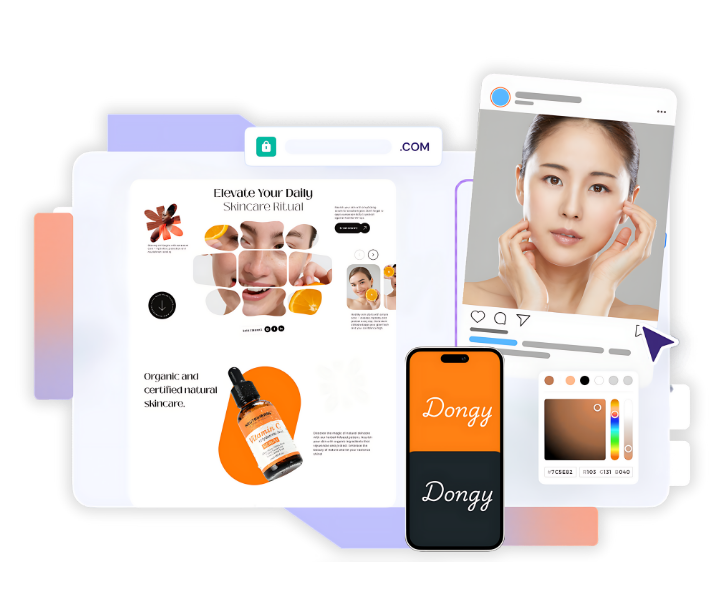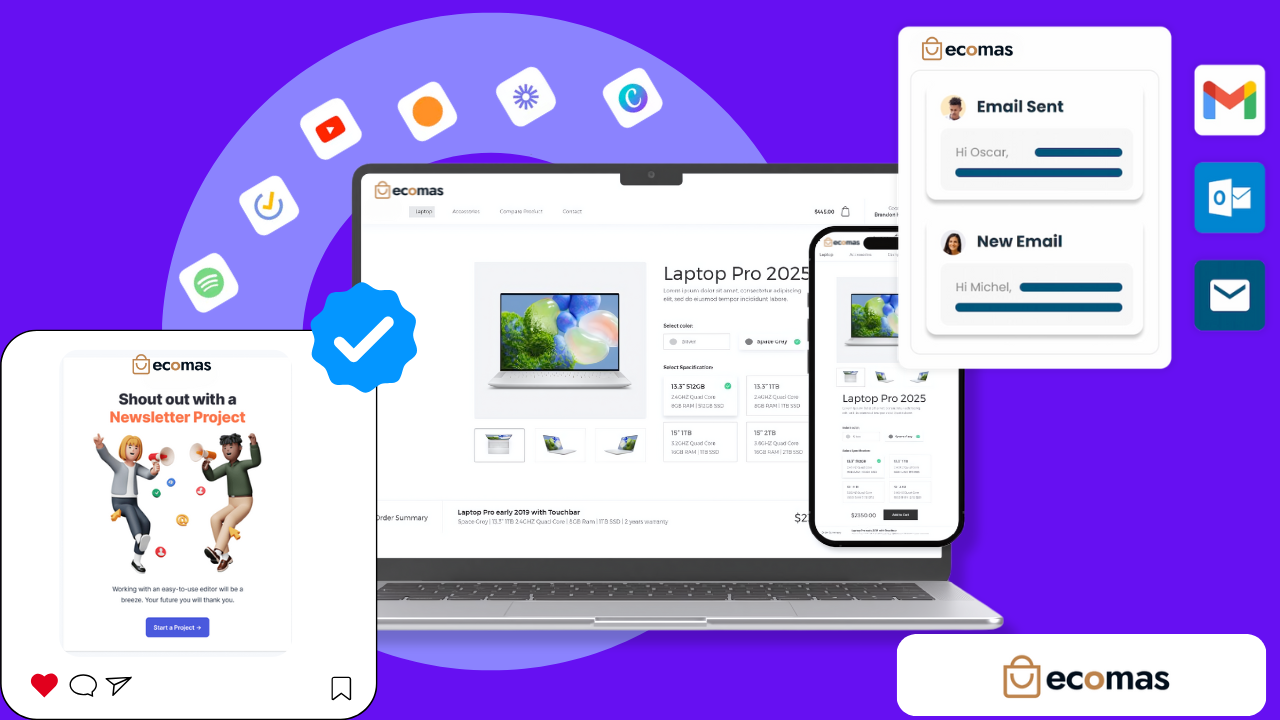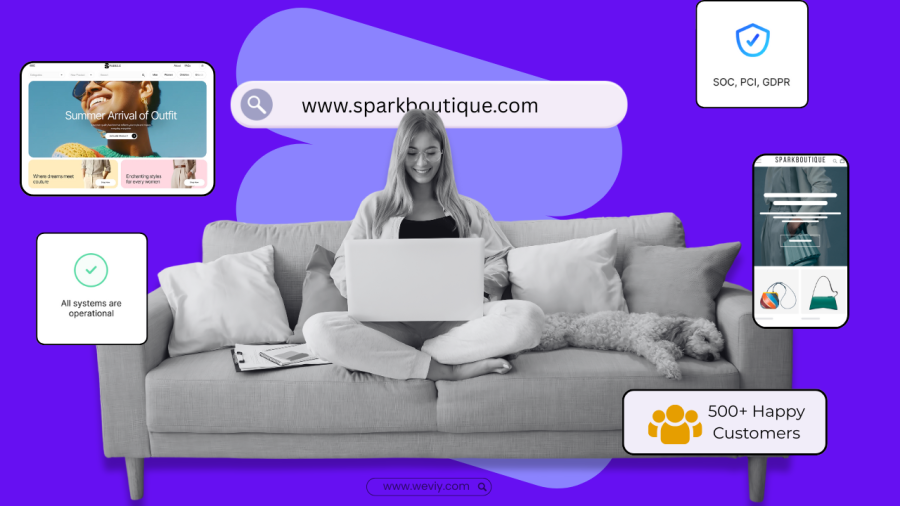Hash Tags
Categories
Post Stats
Author
Weviy
Admin & Content Publisher
Recent Posts
You've probably heard it a thousand times: "You need a strong brand to succeed online." But then you look at the price tags for brand consultants, graphic designers, copywriters, and marketing teams, and suddenly that advice feels like it's only meant for businesses with six-figure marketing budgets.
Here's what nobody tells you: some of the most powerful brands you interact with every day were built by one person sitting at their kitchen table, figuring it out as they went along. The tools, templates, and strategies that used to cost tens of thousands of dollars are now accessible to anyone willing to put in the work.
Building a powerful online brand isn't about having unlimited resources or hiring the perfect team. It's about understanding what makes brands memorable, then systematically applying those principles using the right tools and strategies. The difference between brands that fade into the background and brands that customers actively seek out often comes down to consistency, authenticity, and smart positioning rather than massive budgets.
Understanding What Brand Really Means
Before diving into tactics and tools, it's crucial to understand what we're actually building. Your brand isn't your logo, your color scheme, or your website design, though those elements certainly play important roles. Your brand is the feeling people get when they think about your business. It's the reputation you build, the promises you make and keep, and the experience you consistently deliver.
Think about brands you genuinely love and trust. What makes you choose Apple over Samsung, or Netflix over other streaming services, or your favorite local coffee shop over Starbucks? It's rarely about the product alone. It's about how these brands make you feel, what they stand for, and how consistently they deliver on their promises.
This understanding is liberating because it means you don't need expensive agencies to build something powerful. You need clarity about what you want your brand to represent, consistency in how you present that brand, and patience to let it develop over time. The most successful solo entrepreneurs understand that brand building is a marathon, not a sprint, and they focus on getting the fundamentals right rather than chasing every new trend or tactic.
Your brand strategy starts with understanding your unique position in the market. What makes your business different from every other option your customers have? This isn't about being completely original because truly original ideas are rare. It's about finding the intersection of what you do well, what your customers need, and what your competitors aren't providing.
Consider how you want customers to describe your business to their friends. Do you want to be known as the fastest, the most reliable, the most innovative, the most affordable, or the most personal? You can't be everything to everyone, so choosing your brand positioning means accepting that some people won't be attracted to what you're offering, and that's perfectly fine.
Developing Your Brand Foundation

Every powerful brand starts with a solid foundation, and you can build this foundation yourself with some dedicated thinking and planning. Your brand foundation consists of your mission, values, personality, and unique value proposition. These elements guide every decision you make about how to present your business to the world.
Your mission statement doesn't need to be complicated or revolutionary. It simply needs to clearly communicate why your business exists and what you're trying to accomplish. The best mission statements are specific enough to guide decision-making but broad enough to allow for growth and evolution. Instead of saying "we provide excellent customer service," you might say "we help small business owners save time on administrative tasks so they can focus on growing their companies."
Your brand values are the principles that guide how you operate and make decisions. These aren't just nice words to put on your website; they should actually influence how you run your business. If one of your values is transparency, that should be reflected in how you communicate with customers, how you handle mistakes, and how you present your pricing. If you value innovation, that should show up in how you solve problems and develop new offerings.
Brand personality is where you decide how your business will "sound" when it communicates. Are you professional and authoritative, or friendly and approachable? Are you playful and creative, or serious and trustworthy? This personality should be consistent across all your communications, from your website copy to your social media posts to your customer service interactions.
Your unique value proposition ties everything together by clearly articulating what makes you different and why customers should choose you. This isn't just a list of features or benefits; it's a compelling statement about the transformation you provide or the problem you solve in a way that others don't.
Creating Visual Brand Elements That Work
Visual branding is often where solo entrepreneurs feel most intimidated, but it's also where you can make the biggest impact with the right approach. You don't need to be a graphic designer to create visual elements that look professional and reinforce your brand message.
Color psychology plays a significant role in how people perceive your brand. Different colors evoke different emotions and associations, and choosing the right color palette can reinforce your brand personality and help you stand out from competitors. Blues tend to convey trust and reliability, which is why so many financial and technology companies use blue in their branding. Greens are associated with growth, health, and sustainability. Reds create urgency and excitement. Purples suggest luxury and creativity.

The key is choosing colors that align with your brand personality and appeal to your target audience, then using them consistently across all your materials. This doesn't mean everything needs to be the exact same color, but you should have a defined palette that you stick to. Many successful brands use one primary color, one or two secondary colors, and neutral colors like black, white, or gray to create balance.
Typography is another powerful branding tool that's often overlooked. The fonts you choose communicate almost as much as the words themselves. A playful, handwritten font conveys a very different message than a clean, modern sans-serif font or a traditional serif font. The key is choosing fonts that support your brand personality and are readable across all the platforms where you'll use them.
You don't need dozens of fonts; in fact, limiting yourself to two or three fonts that work well together will create more consistent, professional-looking materials. Many successful brands use one font for headlines and another for body text, with perhaps a third accent font for special situations.
Logo design is where many people get stuck, but it doesn't have to be complicated. The most effective logos are often surprisingly simple. Think about Nike's swoosh, Apple's apple, or McDonald's golden arches. These logos work because they're memorable, scalable, and closely associated with the brand experience.
If you're creating your own logo, focus on simplicity and scalability. Your logo needs to look good whether it's tiny on a business card or large on a billboard. It should work in color and in black and white. It should be recognizable even when it's very small. Complex logos with lots of details often fail these tests.
Building Your Online Presence Strategically

Your website is often the first substantial interaction people have with your brand, so it needs to make a strong impression while clearly communicating what you do and why visitors should care. The most effective business websites aren't necessarily the most visually stunning; they're the ones that make it easy for visitors to understand the value being offered and take the next step.
Website design has evolved significantly in recent years, with users expecting faster loading times, mobile optimization, and intuitive navigation. You don't need to follow every design trend, but you do need to ensure your site works well on all devices and loads quickly. Studies show that visitors will leave a website if it takes more than three seconds to load, so performance is crucial.
The content on your website should reflect your brand personality and clearly communicate your value proposition. This means writing in a voice that's consistent with your brand personality and organizing information in a way that makes sense to your visitors, not necessarily to you. Many business owners make the mistake of organizing their website around their internal structure rather than around what visitors are looking for.
Your homepage should immediately communicate what you do, who you serve, and what makes you different. Visitors should be able to understand your business within seconds of landing on your site. This doesn't mean cramming everything onto your homepage; it means being clear and concise about your core message.
Social media presence is another crucial component of your online brand, but it's important to be strategic about which platforms you use. You don't need to be on every social media platform; you need to be on the platforms where your customers spend time, and you need to be consistent in how you present your brand across those platforms.
Each social media platform has its own culture and best practices, but your brand personality should remain consistent regardless of where you're posting. If your brand is professional and authoritative, that should come through whether you're posting on LinkedIn, Facebook, or Instagram. The format might change, but the voice and values should remain consistent.
Content creation for social media doesn't have to be overwhelming if you plan ahead and batch your work. Many successful solo entrepreneurs spend a few hours each week creating content for the entire following week, then use scheduling tools to post consistently without having to be online constantly.
Content Strategy That Builds Brand Authority
Content marketing is one of the most effective ways to build brand authority and attract customers, but it requires a strategic approach to be effective. Random blog posts or social media updates won't build a strong brand; you need content that consistently reinforces your brand message and provides genuine value to your audience.
Your content strategy should align with your brand positioning and target audience needs. If you're positioning yourself as the go-to expert for small business marketing, your content should consistently provide valuable marketing insights and advice. If you're building a brand around sustainable living, your content should focus on practical sustainability tips and information.
The most successful content strategies focus on answering the questions your potential customers are asking and solving the problems they're facing. This approach builds trust and positions you as a helpful resource rather than just another business trying to sell something. Over time, this approach leads to stronger customer relationships and more referrals.
Consistency is crucial in content marketing, both in terms of publishing schedule and brand voice. It's better to publish one high-quality piece of content per week consistently than to publish daily for a month and then disappear for six months. Your audience needs to know what to expect from you, and algorithms on various platforms reward consistent posting.
Blog content allows you to dive deeper into topics and provide comprehensive value to your audience. Blog posts also help with search engine optimization, making it easier for potential customers to find you when they're searching for solutions you provide. The key is writing content that serves your audience while naturally showcasing your expertise and approach.
Video content has become increasingly important across all platforms, but it doesn't have to be complicated or expensive to produce. Many successful entrepreneurs create valuable video content using just their smartphone and basic editing apps. The key is focusing on providing value rather than achieving perfect production quality.
Email marketing remains one of the most effective ways to build relationships with your audience and maintain consistent contact with potential customers. Building an email list should be a priority from the beginning, even if you only have a few subscribers initially. Email gives you direct access to people who have expressed interest in what you do, without relying on social media algorithms or search engine changes.
Leveraging Technology and Tools
The technology landscape has dramatically democratized brand building, giving solo entrepreneurs access to tools and capabilities that were once only available to large companies with significant budgets. Understanding which tools to use and how to use them effectively can dramatically accelerate your brand building efforts.
Website building platforms have evolved to the point where you can create professional-looking websites without any coding knowledge. Modern website builders include templates designed by professional designers, built-in SEO optimization, mobile responsiveness, and integration with various business tools. The key is choosing a platform that grows with your business and allows for customization as your brand evolves.
Design tools have also become much more accessible, with platforms offering professional-quality templates and easy customization options. You can create everything from social media graphics to business cards to email newsletters using drag-and-drop interfaces and professional templates. The key is maintaining consistency across all your materials by sticking to your defined color palette, fonts, and style guidelines.
Social media management tools allow you to maintain a consistent presence across multiple platforms without spending all day posting and responding to comments. These tools let you schedule content in advance, monitor mentions of your brand, and analyze the performance of your posts. This automation allows you to focus on creating great content and building relationships rather than managing the technical aspects of social media posting.
Email marketing platforms provide sophisticated automation capabilities that allow you to nurture relationships with potential customers over time. You can set up automated sequences that introduce new subscribers to your brand, provide valuable content, and gradually introduce your products or services. These systems work in the background, providing value to your audience and building relationships even when you're focused on other aspects of your business.
Analytics tools help you understand what's working and what isn't in your brand building efforts. You can track website traffic, social media engagement, email open rates, and conversion rates to understand which aspects of your brand resonate most with your audience. This data allows you to refine your approach over time and focus your efforts on the strategies that produce the best results.
Customer relationship management systems help you keep track of interactions with potential and current customers, ensuring that nothing falls through the cracks. Even as a solo entrepreneur, you can provide a level of personalized service that larger companies struggle to match by using technology to organize and automate routine tasks while focusing your personal attention on high-value interactions.
Building Brand Consistency Across All Touchpoints

Brand consistency is what transforms a collection of individual interactions into a cohesive brand experience. Every time someone encounters your business, whether through your website, social media, email communications, or customer service, they should have a consistent experience that reinforces your brand identity.
This consistency starts with developing clear brand guidelines for yourself, even if you're the only person who will use them. Document your color palette with specific color codes, define your font choices, establish your brand voice and tone, and create templates for common materials. Having these guidelines written down ensures that you maintain consistency even when you're busy or creating content quickly.
Visual consistency means using the same colors, fonts, and design elements across all your materials. Your website header should use the same fonts and colors as your social media graphics, which should match your email newsletters and business cards. This doesn't mean everything needs to look identical, but there should be clear visual connections that tie everything together.
Voice consistency means maintaining the same personality and tone across all your written communications. If your brand personality is friendly and approachable, that should come through whether someone is reading your website copy, your social media posts, or your email newsletters. If your brand is more professional and authoritative, that tone should be consistent across all platforms.
Message consistency means that your core value proposition and key brand messages should be reinforced across all your communications. You don't need to say exactly the same thing everywhere, but the fundamental message about what you do and why people should care should be consistent whether someone encounters you on social media, your website, or through word-of-mouth referrals.
Customer experience consistency extends beyond marketing materials to include how you handle customer service, deliver your products or services, and follow up with customers. Every interaction someone has with your business should reinforce your brand values and personality. This is where many small businesses have an advantage over larger companies because you can ensure that every customer interaction reflects your brand standards.
Measuring and Refining Your Brand Impact
Building a powerful brand is an ongoing process that requires regular evaluation and refinement. You need systems in place to understand how your brand is being perceived, which aspects are working well, and where there might be opportunities for improvement.
Brand awareness can be measured through various metrics, including website traffic, social media followers and engagement, email list growth, and search volume for your business name. While these metrics don't tell the complete story, they provide useful indicators of whether your brand building efforts are reaching more people over time.
Brand perception is harder to measure but equally important. Customer feedback, reviews, and testimonials provide insights into how people perceive your brand and whether your intended brand personality is coming through in their experience. Regular surveys or informal conversations with customers can provide valuable insights into how your brand is being received.
Business results ultimately determine whether your brand building efforts are successful. Are you attracting more qualified leads? Are customers choosing you over competitors? Are people willing to pay premium prices for your products or services? Are you receiving referrals from satisfied customers? These outcomes indicate whether your brand is creating real value for your business.
The key is tracking these metrics consistently over time rather than looking for immediate dramatic changes. Brand building is a long-term strategy, and the most significant impacts often become apparent over months or years rather than weeks. However, you should see gradual improvements in brand awareness, customer response, and business results if your strategy is working.
Based on your analysis, you may need to refine various aspects of your brand strategy. Perhaps certain messages resonate better with your audience than others, or maybe specific visual elements are more effective than you initially thought. The goal isn't to constantly change your brand, but to evolve and improve it based on real feedback and results.
Scaling Your Brand as You Grow

One of the advantages of building your brand systematically from the beginning is that it creates a foundation that can support growth. As your business expands, your brand guidelines and systems allow you to maintain consistency even as you add team members, expand into new markets, or launch new products or services.
Documentation becomes crucial as you grow. The brand guidelines you created for yourself become training materials for team members. The systems and processes you developed allow others to maintain brand consistency without constant oversight. The content templates and visual assets you created can be used and adapted as your business evolves.
Hiring decisions should consider brand fit as well as skills and experience. As you add team members, whether employees or contractors, they become representatives of your brand. Their interactions with customers and their work quality reflect on your brand, so it's important to find people who understand and can embody your brand values.
Brand evolution is natural and necessary as your business grows, but it should be strategic rather than reactive. Your core brand identity can remain consistent while surface elements like visual design or messaging evolve to stay current and relevant. The key is making changes deliberately while maintaining the fundamental brand promise and personality that attracted customers in the first place.
Your brand is one of your most valuable business assets, and building it strategically from the beginning creates a competitive advantage that becomes stronger over time. Customers who connect with your brand become more than just buyers; they become advocates who refer others and choose you even when cheaper alternatives are available.
Building a powerful online brand without hiring a team requires dedication, consistency, and strategic thinking, but it's absolutely achievable. The tools and resources available today make it possible for solo entrepreneurs to create brands that compete effectively with much larger organizations. The key is understanding what makes brands powerful, then systematically applying those principles using the right combination of strategy, creativity, and technology.
Your brand is your business's reputation, personality, and promise all rolled into one. When you build it thoughtfully and maintain it consistently, it becomes a powerful asset that attracts customers, commands premium prices, and creates sustainable competitive advantages. The investment of time and effort you put into building your brand today will pay dividends for years to come.
Ready to build a brand that stands out and drives real business results? Start with your foundation and build systematically from there.

